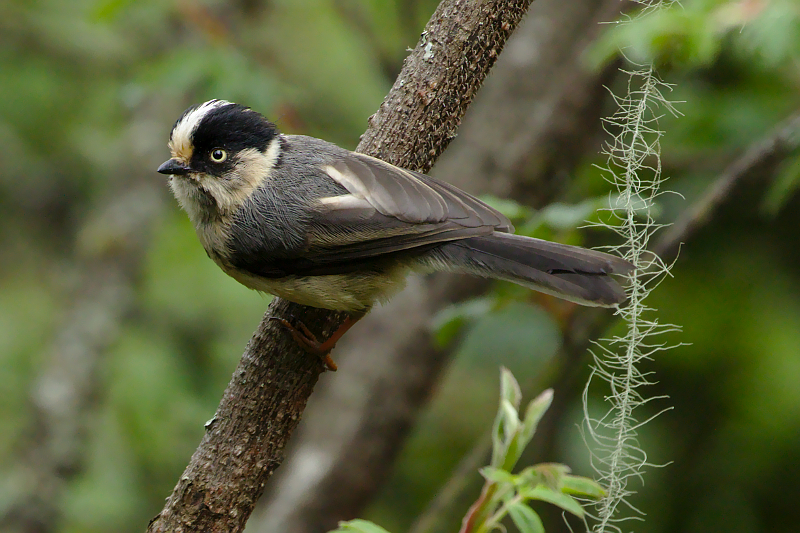On day five we drove east from Punakha and noticed that the main road that we were traveling on was very variable in quality, and major roadworks were underway. We came across a number of interesting species although the conditions for photography were not optimal. White-tailed Nuthatch, Blue-throated Barbet, Whiskered Yuhina, Rusty-flanked Treecreeper, Chestnut-bellied Rock-thrush were nice additions and a gorgeous Little Forktail near a waterfall…..a ‘lifer’ for most of us.
Later in the afternoon we stopped near an area of coniferous-forest before descending into the Phobjikha Valley, this was quite productive with a variety of species showing well. I finally managed to see a male Slaty-blue Flycatcher, Easy got a nice look at a White-collared Blackbird and we all had good views of Rufous-fronted Tit and Grey Bushchat amongst others.
Ebird Lists for Punakha to Phobjikha
After a comfortable evening in the hotel at Phobjihka we drove to Pele La, weather was overcast and quite misty. Our first sighting was a wonderful male Himalayan Monal en-route. At Pele la we took a long walk around the area, birding was quiet at first, becoming better as the sun appeared Red-headed and Brown Bullfinch, Ashy-throated Leaf Warbler, Rufous-vented and Stripe-throated Yuhina, Dark-sided Flycatcher, Yellow-bellied Fairy-Fantail, Brownish-flanked Bush Warbler, Rufous-gorgetted Flycatcher, Gold-naped and Scarlet Finch all showing well but the hardest species to see were the calling Lesser Cuckoos which though seemingly metres away, wouldn’t show until one eventually flew over us. There were also plenty of Pikas, small mammals related to rabbits and a lone Musk Deer…apparently quite rare in Bhutan these days. Pele La is definitely a place to return to.
Ebird list for Phobjihka Valley
From Pele La we made our way to the large town of Trongsa, famous for it’s picturesque Dzong (or castle) this is an administration capital and large educational-facility, we stayed at a beautiful Yangkhil Resort and admired the incredible views. For 60 kms before Trongsa we had travelled through one of the most spectacular (…and very intimidating) roads that I had ever been on. Road-works were taking place for the whole 60 kms and all three visitors wished there was a less-adventurous way of getting to the eastern-part of the country…..according to our driver there was, we could fly from Paro to Bumthang (…or vice-versa), but only if it wasn’t raining. More on that later….
After quite an ‘arduous-day’ we ended with a drive to the Choedrak Monastery and after a long-walk from the car park to the buildings (…and a bit of ‘high-altitude’ over-exertion) we found a superb Himalayan Monal only metres away feeding on food-scraps from the monks. Later we saw 4 (all males) a little closer as we returned to the car-park!

Aching a little after the previous evenings exertions, we made our way from Jakar to Ura and on entering a forest near Sengor we came across one of the ‘target-species’ a beautiful male Satyr Tragopan, initially it was a little cautious but returned and then proceeded to display, showing the blue throat-patch and ‘whirring’ it’s wings, my images were quite poor due to the low light but I recorded the call.

Shortly after the ‘exhilaration’ of the tragopan, our guide spotted a pair of Blood Pheasant which allowed reasonably close views (…although the light was far from optimal and pics very poor.)

Eastwards from Trongsa the scenery became increasingly mountainous and we kept our eyes on cliffs for colonies of hirundines, searching for the ‘elusive’ Nepal House Martin, eventually seeing a handful amongst the large numbers of Asian House Martin differing with their dark throats. Sadly, due to poor-light and weather-conditions I failed to record any with my camera.
Soon we made it to Thrumsingla (Phrumsengla?) National Park, and the birding became even more interesting, sprawling pine and mixed forests …..apparently the habitat of Red Panda. We arrived at a small sanctuary known as the “Rhododendron Walk” and saw some interesting birds such as Northern Wren, Chestnut-throated Minla ( or as it’s often known Bar-winged Siva) but for me there were two ‘target-species’ to find there, Fire-tailed Sunbird and Fire-tailed Myzornis. The former was fairly difficult to miss and incredibly spectacular (…Oh for some sunshine, though!) the latter took some searching but our guide proved his worth and we finally got tantalising glimpes of the Myzornis (…a species that I have wanted to experience since first seeing pics, decades before!)
Ebird list for Phrumsengla (Rhododendron Walk)
Part 1 | Part 2 | Part 4 | Part 5 | list





























































